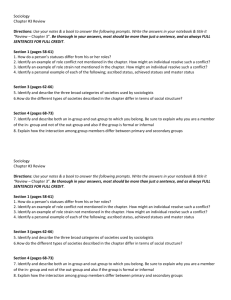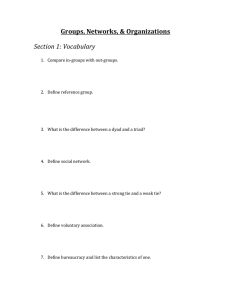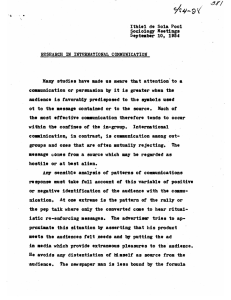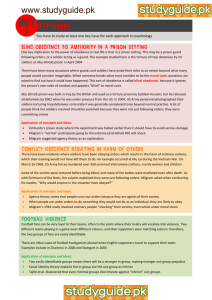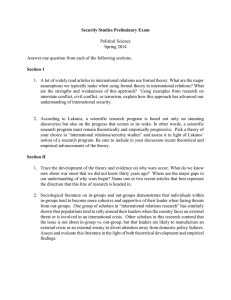Enterprise College - Leadership Lecture 3
advertisement
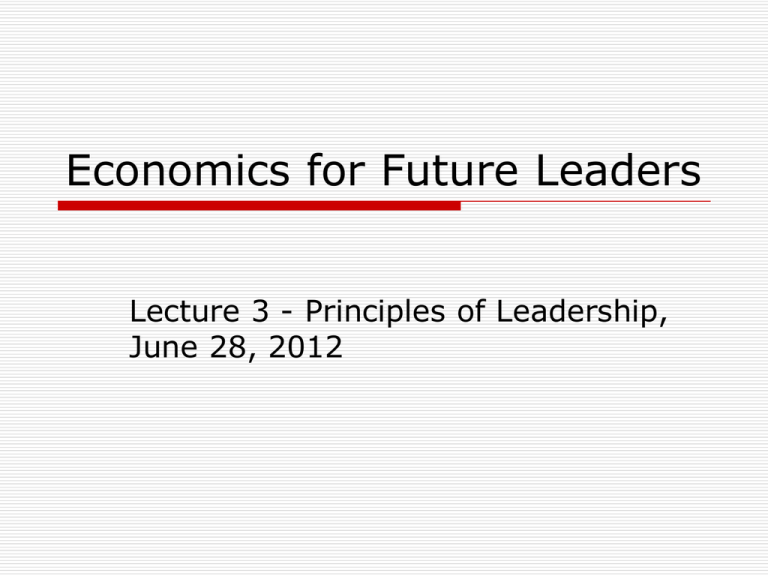
Economics for Future Leaders Lecture 3 - Principles of Leadership, June 28, 2012 Creating a Vision An effective leader creates compelling visions that guide people’s behavior. In the context of leadership, a vision is a mental model of an ideal future state. The Characteristics of a Vision A picture (a future better than the status quo). A change (a change in the status quo). Values (a linkage of one’s own values, the values of others, and the organization’s values). A map (a laid-out path to follow). A challenge (transcend status quo to do something better for others). Articulating a Vision Adapt the vision to his or her audience. Highlight the values of the vision. Choose the right language (words and symbols). Implementing a Vision Model to others the attitudes, values, and behaviors set forth in the vision. Set high performance expectations for others. Encourage and empower others to reach their goals. Setting the Tone Provide structure. Communicate the group’s goals (course syllabus, meeting agenda). Identify unique ways that each individual member can contribute to the group. Clarify norms (shared rules of group behavior). Develop constructive norms early in group development. Setting the Tone Build cohesiveness (the sense of “we-ness” in a group. Positive outcomes. Increased participation. Better interaction. More consistent membership. Positive feelings. Improved attendance. Mutual influence. Conformity to group norms. Goal-directed behavior. High satisfaction. More productivity. Setting the Tone Build cohesiveness (how?). Help groups create a climate of trust. Invite group members to become active participants. Encourage passive or withdrawn members to become involved. Be willing to listen and accept group members for who they are. Help group members to achieve their individual goals. Promote the free expression of divergent viewpoints in a safe environment. Allow group members to share the leadership responsibilities. Foster and promote member-to-member interaction instead of just leader-follower interaction. Setting the Tone Promote standards of excellence. Six factors. What group members need to know and what skills they need to acquire. How much initiative and effort they need to demonstrate. How group members are expected to treat one another. The extent to which deadlines are significant. What goals they need to achieve. What the consequences are if they achieve or fail to achieve these goals. Setting the Tone Promote standards of excellence. How to achieve standards (the 3 Rs). Require results (clear, concrete expectations). Review results (constructive feedback and resolving performance issues). Reward results (provide rewards of group and individual achievement). Listening to Out-Group Members Out-group members are at odds in some way with the larger group. Why do they form? Disagreement with the social, political, or ethical position of the majority. Inability to identify with the beliefs, norms, or values of the majority. Perceived exclusion by the majority. Lack of communication or social skills. Listening to Out-Group Members What is the impact of out-groups? Run counter to the building of community. Have a negative impact on group synergy. Do not receive the respect they deserve from the majority. Listening to Out-Group Members Strategies for responding to out-groups. Listen to out-group members. Show empathy to out-group members. Recognize the unique contributions of out-group members. Help out-group members feel included. Create a special relationship with out-group members. Give out-group members a voice and empower them to act. Overcoming Obstacles Unclear goals. Make goals clear and understandable. Unclear directions. Define the path to the goal by giving clear directions. Low motivation. Expectancy theory: the effort (competence) they put into a task leads to an expected outcome (achievable and likely to occur) that they value. Individuals should feel competent, get what they expect, and value what they do. This will maximize motivation. Overcoming Obstacles Complex tasks. Apply directive leadership – take charge and clarify the path to the goal. Simple tasks. Apply supportive leadership – apply human connection when task is boring and repetitive. Low involvement. Apply participative style – invite others to share in the ways and means of getting things done. Lack of a challenge. Apply achievement-oriented style – challenge individuals to perform at the highest level possible. Ethics in Leadership The character of the leader (Nelson Mandela versus Bill Clinton). Trustworthiness. Respect. Responsibility. Fairness. Caring. Citizenship. The actions of the leader (Abu Ghraib) Show respect. Serve others. Show justice. Ethics in Leadership Goals of the leader (Adolf Hitler, Al-Qaeda terrorists, Mother Teresa). The goals reflect the ethics of a leader. Honesty of the leader. Power of the leader. Referent power (identification). Expert power (competence). Legitimate power (authority). Reward power (transaction). Coercive power (force or punishment). Ethics in Leadership Values of the leader. Ethical values ([character] e.g., kindness, altruism). Modal values ([means or actions] e.g., responsibility and accountability). End values ([outcomes or goals] e.g., justice and community). Summary of Leadership Components Recognizing your traits [Traits]. Intelligence Confidence Charisma Determination Sociability Integrity Summary of Leadership Components Recognizing your philosophy and style of leadership [Philosophy, Style] Philosophy Theory X Theory Y Style Authoritarian Democratic Laissez-Faire Summary of Leadership Components Attending to tasks and relationships [Behaviors] Task-oriented style. Relationship-oriented style. Developing leadership skills [Skills] Administrative Interpersonal Conceptual Summary of Leadership Components Creating a vision [Vision] A picture A change Values A map A challenge Provide structure Clarify norms Build cohesiveness Promote standards of excellence Setting the Tone [Tone] Summary of Leadership Components Listening to Out-Group Members [Tolerance, Sensitivity] Listen Show empathy Recognize unique contributions Help out-group feel included Create special relationship Give out-group a voice and power to act. Summary of Leadership Components Overcoming obstacles [Obstacles] Unclear goals Unclear directions Low motivation Complex tasks Simple tasks Low involvement Lack of a challenge Summary of Leadership Components Addressing ethics in leadership [Ethics] Character Actions Goals Honesty Power Values Leadership Question #3 One of the central responsibilities of a leader is to help his or her followers become motivated. This means helping feel competent, helping them meet their expectations, and helping them value what they do. How would you apply these three principles in a leadership situation? Be specific.

